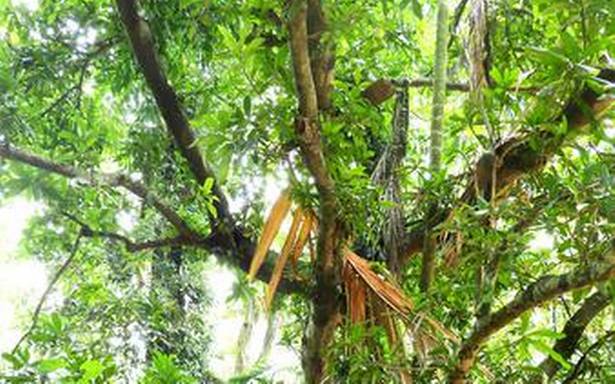Researchers name it Madhuca balakrishnanii after late Balakrishna Pillai who preserved it in his compound
An evergreen tree lovingly protected by a family in Thodiyoor panchayat in Kollam district has turned out to be a new species of the genus Madhuca.
Researchers at the Jawaharlal Nehru Tropical Botanic Garden and Research Institute (JNTBGRI), Palode, who made the identification have named it Madhuca balakrishnanii (family Sapotaceae) after the late Balakrishna Pillai of Madathinal Thekkatthil, Muzhangodi, who preserved it as a ‘star tree’ in his compound. A paper on the discovery by E.S. Santhosh Kumar, S. Shailajakumari, and S. Muhammed Shareef of JNTBGRI has been published in the journal Phytotaxa.
What led to the tree’s identification makes for an interesting story. In 2020, a JNTBGRI team, which included Dr. Santhosh Kumar and Dr. Shailajakumari, had published the discovery of another species of the same genus, Madhuca diplostemon, which was long thought to be extinct, from a sacred grove in Paravur, Kollam.
“After that, we began receiving calls from people who claimed they had the same tree at their places. Most of them turned out to be the common ‘Ilippa’ (Madhuca neriifolia), but the call from Thodiyoor was different. The family sent us some photographs of the tree and we realised that it was something else altogether,” Dr. Santhosh Kumar said.
The JNTBGRI team made a number of visits to Thodiyoor and collected samples. The tree in question was an evergreen, growing to a height of eight metres with fluted, slightly fissured bark. It produced tasty fruits and the flowers were also sweet-tasting. Subsequent examination established it as a hitherto unreported species of Madhuca.
“Apparently, Mr. Balakrishna Pillai had cherished it as a ‘star tree’ associated with the ‘Revathi nakshatra.’ His children and grandchildren also continued to protect it,” Dr. Santhosh Kumar said. Physical characteristics, including hairy young shoots, fairly long stipules, sparsely hairy pedicels and ovoid fruit, distinguish Madhuca balakrishnanii from the two allied species Madhuca diplostemon and Madhuca insignis.
The known population of Madhuca balakrishnanii consists of just three mature trees and several seedlings of various ages within a one sq km area. Under the IUCN Red List criteria, the species can be classified as ‘critically endangered’, the paper on it in Phytotaxa noted.
Source: Read Full Article

